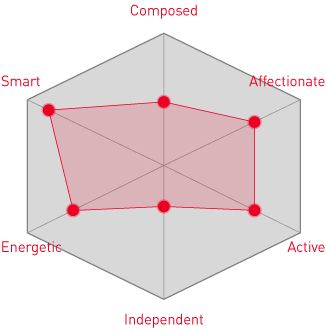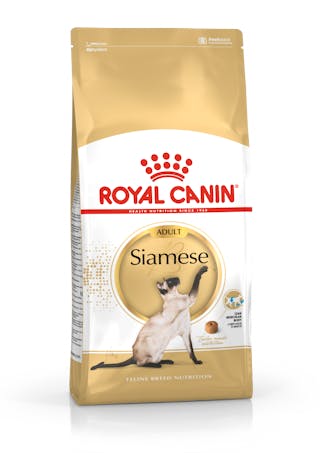
Let's talk Siamese Cats
With their sleek, sassy looks, and almost regal-like bearing, the Siamese is often regarded as one of the most archetypal and beautiful breeds of cat. And yet, in their temperament, the Siamese is almost more dog-like. Affectionate, sociable and playful, they form strong attachments to their owners and enjoy being with children and other pets. They also have their own favourite toys and never tire of games – even fetch!
Official name: Siamese
Other names: Royal Cat of Siam
Origins: Thailand

| Hair length |
|
Family Pet* |
 |
| Shedding level |  |
Cohabitation with other pets |  |
| Grooming needs |  |
Can stay alone* |
 |
| Energy Level* |  |
Environment (indoor/outdoor) |  |
| Vocal tendencies | High |
* We advise against leaving pets alone for long stretches. Companionship can prevent emotional distress and destructive behaviour. Speak to your veterinarian for recommendations.
Every pet is different, even within a breed; this snapshot of this breed specifics should be taken as an indication.
For a happy healthy and well-behaved pet, we recommend educating and socializing your pet as well as covering their basic welfare needs (and their social and behavioral needs).
Pets should never be left unsupervised with a child.
Contact your breeder or veterinarian for further advice.
All domestic pets are sociable and prefer company. However, they can be taught to cope with solitude from an early age. Seek the advice of your veterinarian or trainer to help you do this.


| Baby age | Birth to 4 months |
| Growing kitten age | 4 to 12 months |
| Adult age | 1 to 7 years |
| Mature age | 7 to 12 years |
| Senior age | From 12 years |

1/7
Get to know the Siamese
All you need to know about the breed
As the old expression goes, “nobody owns a cat”. But, if they did, it would probably be a Siamese.
Definitely one of the friendlier feline breeds, they revel in being with people and can often bond strongly with a single person. They also thrive on attention and interaction. In fact, in some ways, the Siamese cat temperament is more like that of a dog.
Once known as the Royal Cat of Siam, the Siamese breed has always been closely associated with Thailand, although their precise origins remain somewhat shrouded in mystery. What we do know is that they were brought over to the West in the late 19th century to a mixed reception – as no one had ever seen their like before – but that they soon became popular pets.
Not for nothing were they named the ‘Royal’ Cat of Siam. With their long, graceful body, and extended neck, they wouldn’t look out of place on the Egyptian tomb of a pharaoh. They also have slender legs, an elegant head and striking almond-shaped eyes that are a deep blue colour.
Easy to take care of, their coat is short and smooth, accentuating their lithe, muscular bodies. There are also several types of Siamese cat colours, ranging from tabby and tortoiseshell to smoke, silver and fawn.
Highly intelligent, the Siamese cat has personality in spades. They’ll be interested in everything that you’re doing and often follow their owners like a shadow. They are also surprisingly ‘chatty’ animals and will try to communicate with you in their own unique way – sounding quite unlike any other cat.
A regular fixture in popular culture, the Siamese has been depicted in paintings and books for centuries. On our screens, they have also featured in several Walt Disney films including Lady and the Tramp (1955), The Incredible Journey (1963), That Darn Cat (1965) and Aristocats (1970). More recently, one of the most popular Pokémon species was based on a Siamese cat.

2/7
2 facts about Siamese cats
1. A perfect symmetry
With their elegant, angular bodies, the Siamese cat is often thought to look almost other-worldly. But did you know that if you measure from the tip of the nose to each tip of the ear, their face also forms a perfect triangle?
2. Two is company
Given their sociable nature, Siamese cats don’t do well if left alone. So, for human owners who may need to be out during the day, it’s generally recommended to consider having a second Siamese. That way, they can keep each other company.
History of the breed
Dating back many centuries, the first known reference to the Siamese breed occurs in a collection of ancient manuscripts from the historic Ayutthaya Kingdom in Siam – what is now modern-day Thailand. Entitled ‘The Treatise on Cats’, these fascinating documents are thought to have been created from the 14th century onwards.
It wasn’t until the 1800’s, however, that the Siamese found its way to the West. Originally known as the Royal Cat of Siam, they received something of a mixed reaction here initially, as no one had seen anything like them before. In fact, in 1871, when three were shown at London’s Crystal Palace Show, they were given a decidedly lukewarm reception.
However, it wasn’t long before the Siamese breed took off, going on to become a very fashionable pet. The first standard was established in the UK in 1892 and they were soon in demand on both sides of the pond.
Today, there are actually two types of Siamese cat. The reason for this is that, due to selective breeding, there developed two sub-breeds of Siamese: the modern ‘Show-style’, which is more elongated and slender in the body and has a different-shaped head, and the ‘Traditional’ Siamese.

4/7
From head to tail
Physical characteristics of Siamese cats
1. Head
A wedge-shaped head sits on a long, graceful neck
2. Face
Ears are large and pointed and they have almond-shaped, bright blue eyes
3. Body
Body is long and tubular with slender legs, dainty, oval paws and a long whip-like tail
4. Coat
Short and sleek coat ranges from tabby and tortoiseshell through to smoke, silver or fawn in colour
5. Colouring
Regardless of colouring, can often have darker points on their ears, face, paws and tail

5/7
Things to look out for
From specific breed traits to a general health overview, here are some interesting facts about your Siamese
Siamese cats don't have the best night-time vision
While they may have some of the most striking eyes of any cat, with their piercing blue gaze, they lack a physiological feature that amplifies low light. Many early Siamese cats were actually cross-eyed, which helped to compensate for the problem, but the trait was seen as a fault. As a result, it was largely eliminated through selective breeding. It’s worth knowing all this as their poorer eyesight can make the Siamese more at risk to night-time dangers such as traffic. On the plus side, unlike some other blue-eyed animals, their hearing is unaffected in any way.

6/7
Caring for your Siamese
Grooming, training and exercise tips
One of the other great things about the Siamese breed is that they are very low-maintenance in terms of grooming. All they really need is a quick run-through with a comb once a week to remove any dead hair. The Siamese cat also sheds very little compared to some other breeds. As they are also clean animals, too, they rarely need to be bathed either – though it’s recommended that they have a professional grooming session twice a year. Also, remember to give their ears a check for any signs of infection and to brush their teeth daily, if you can manage, or at least two or three times a week.
7/7
All about Siamese cats
Yes, absolutely – that is one of the main Siamese behaviour traits. In fact, they make excellent companions all-round. However, due to their activity level and intelligence, the Siamese can occasionally get into mischief if left alone. So, they will do best with an owner who wants to spend time with their cat.
One of the longer-lived breeds, Siamese cats live up to around 12 to 15 years on average. However, some can reach 20 years old – and even beyond. So, in short, the life expectancy of a Siamese cat is fairly high.
Tailored nutrition for your Siamese
Read more on this topic

Your guide to buying a kitten

Should I adopt a cat or buy a kitten?

Your guide to adopting a cat

Should I choose a pure breed or mixed breed cat?

The cost of owning a cat
Sources
1 - Veterinary Centers of America https://vcahospitals.com/
2 - Royal Canin Cat Encyclopaedia. Ed 2010 and 2020
3 - Banfield Pet Hospital https://www.banfield.com/
4 - Royal Canin BHN Product Book








